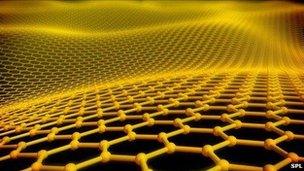Graphene 'could help boost broadband internet speeds'
- Published

The scientists managed to increase the light-harvesting performance of graphene by 20 times
Graphene, the strongest material on Earth, could help boost broadband internet speed, say UK researchers.
Scientists from Manchester and Cambridge universities, have found a way to improve its sensitivity when used in optical communications systems.
Their discovery paves the way for faster electronic components, such as the receivers used in fibre optic data connections.
Graphene was discovered in 2004 and has been hailed as a "wonder material".
Optical communications
The material's use in photo-electrical systems is not new.
Scientists had previously managed to produce a simple solar cell by placing microscopic metallic wires on top of graphene sheets and shining light onto them.
Its superconductive properties meant that electrons could flow at high speed with extreme mobility.
However, early graphene solar cells were not very efficient, as the material was only capable of absorbing about 3% of visible light, with the rest shining through without being converted into power.
The latest research, overcomes that problem by using a method, known as plasmonic enhancement, to combine graphene with tiny metallic structures called plasmonic nanostructures.
As a result, its light-harvesting performance is increased by a factor of 20.
"The technology of graphene production matures day-by-day, which has an immediate impact both on the type of exciting physics which we find in this material, and on the feasibility and the range of possible applications," said Prof Kostya Novoselov, one of the lead researchers.
"Many leading electronics companies consider graphene for the next generation of devices. This work certainly boosts graphene's chances even further."
His colleague Professor Andrea Ferrari from the University of Cambridge added that the results showed the material's "great potential in the fields of photonics and optoelectronics".
Details of the team's work have been published in the journal Nature Communications.
Wonder material
Konstantin Novoselov (pictured left) and Andre Geim received a Nobel Prize for their work on graphene
Graphene was discovered in 2004 after scientists used sticky tape to isolate a single, atom-thick layer of graphite - the same material used in pencils.
It has been identified as the thinnest, strongest and most conductive material in the world; properties which many believe could revolutionise electronics.
Andre Geim and Kostya Novoselov, both originally from Russia, were awarded the Nobel Prize in Physics for their work in 2010.
- Published28 June 2011
- Published5 October 2010